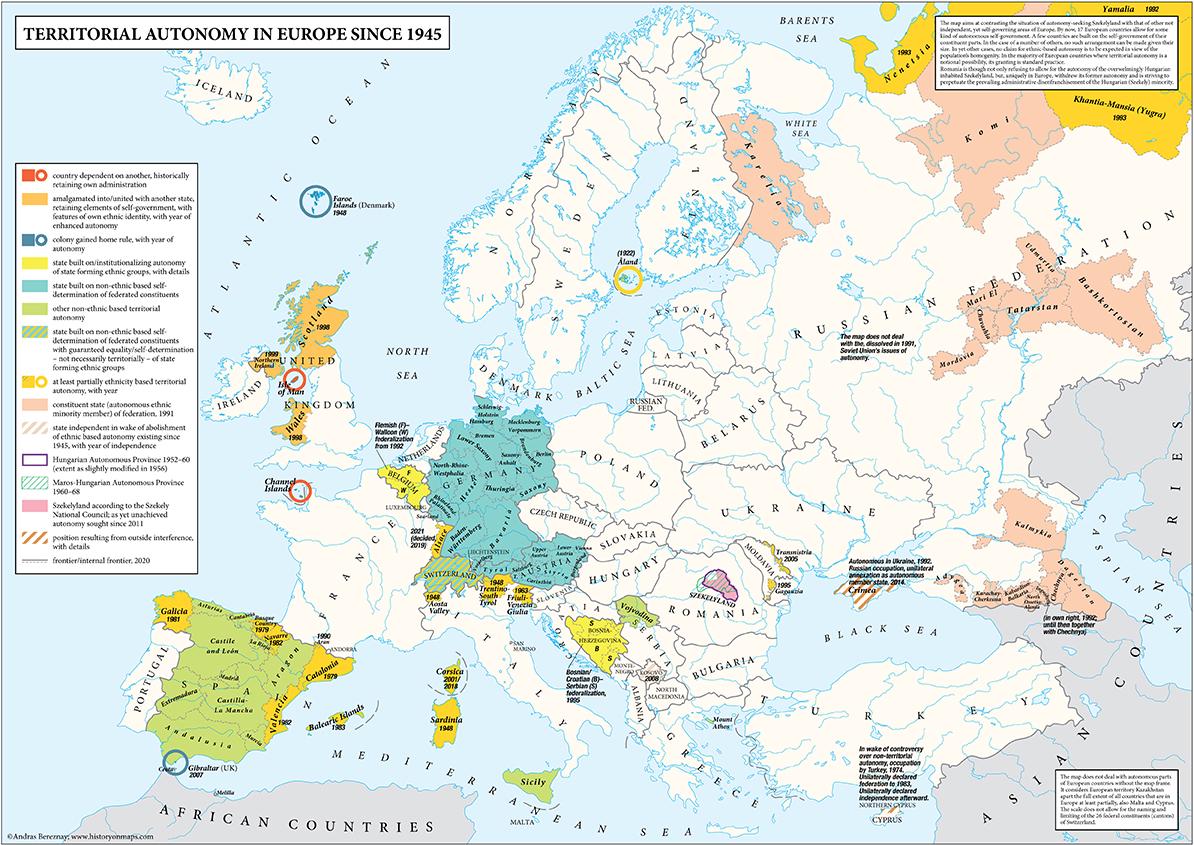Territorial Autonomy in Europe Map


Alex Cartwright
Senior Cartographer & GIS Specialist
Alex Cartwright is a renowned cartographer and geographic information systems specialist with over 15 years of experience in spatial analysis and data...
Geographic Analysis
What This Map Shows
The "Territorial Autonomy in Europe" map provides a comprehensive visualization of the various regions across Europe that have gained varying degrees of autonomy since 1945. This map highlights how political landscapes have shifted in response to cultural, historical, and regional demands for self-governance. Autonomy can manifest in several ways, from administrative powers to legislative independence, and this map captures those nuances across the continent.
Deep Dive into Territorial Autonomy in Europe
Territorial autonomy is a significant aspect of political geography, often reflecting a region's desire to maintain its cultural identity, economic interests, or historical ties. In Europe, the quest for autonomy has led to a patchwork of regions with differing levels of self-governance. This phenomenon gained momentum after World War II, as many nations began to recognize the importance of accommodating distinct regional identities within their borders.
One prominent example is the Basque Country in Spain, which has operated under a high degree of autonomy since the Statute of Autonomy was enacted in 1979. It allows the Basque government to control various aspects such as education, health, and taxation. Similarly, Scotland's devolved parliament has wielded significant powers since 1999, emphasizing local governance in matters like education and health.
Interestingly, the map also illustrates regions like Flanders in Belgium, where linguistic and cultural differences have resulted in a complex federal structure. Flanders has its own parliament and government, allowing for localized decision-making—an arrangement that reflects the necessity of addressing distinct cultural identities within a unified state.
On the other hand, territories such as Greenland, an autonomous territory within the Kingdom of Denmark, showcase unique governance structures. Greenland has gradually gained control over its affairs since 1979, culminating in a self-government arrangement in 2009. This autonomy allows Greenland to manage its resources and decision-making processes, although it still relies on Denmark for certain aspects such as defense and foreign policy.
Autonomy isn’t limited to large, well-known regions. Smaller areas like the Åland Islands in Finland also exemplify this trend. Known for their unique Swedish-speaking population, the islands enjoy a high degree of self-governance and have their own parliament, which administers local laws, thereby preserving their cultural identity within a predominantly Finnish context.
Regional Analysis
By examining the map closely, we can identify key regions where autonomy has either flourished or faced challenges. In Western Europe, countries like Spain and Belgium display a clear trend toward recognizing regional identities, as seen with the Basque Country and Flanders. The political systems in these nations have adapted to allow for such governance structures, reflecting a tolerance for diversity in cultural identities.
In contrast, Eastern Europe presents a more complex picture. For instance, regions such as Kosovo have sought autonomy and independence from Serbia, leading to ongoing tensions. The pursuit of self-governance in Kosovo, declared independent in 2008, remains a contentious issue in the region, reflecting broader geopolitical dynamics.
Furthermore, the map shows that the Nordic countries, particularly Finland and Denmark, have embraced autonomy for smaller regions like the Åland Islands and Greenland. The governance in these territories is often characterized by cooperation and negotiation, aiming to balance local needs with national interests.
Significance and Impact
The topic of territorial autonomy in Europe is crucial for understanding contemporary political dynamics. As globalization continues to influence national borders and cultural identities, the demand for autonomy reflects a broader desire for self-determination and local governance. This has real-world implications, particularly in how regions negotiate their rights and responsibilities within larger state frameworks.
What's fascinating is that as nations evolve, the trend of granting autonomy may expand in response to emerging cultural movements and demographic shifts. With growing awareness and acknowledgment of minority rights, we could see more regions pushing for their voices to be heard. Additionally, the impact of the European Union cannot be understated, as it encourages dialogue and cooperation between regions, fostering an environment where autonomy can be discussed and negotiated.
In conclusion, the map of territorial autonomy in Europe since 1945 serves as a lens through which we can examine the complexities of identity, governance, and politics in a rapidly changing world. Understanding this landscape not only reveals the historical context but also paves the way for anticipating future developments in regional autonomy and self-governance across Europe.
Visualization Details
- Published
- October 23, 2025
- Views
- 6
Comments
Loading comments...